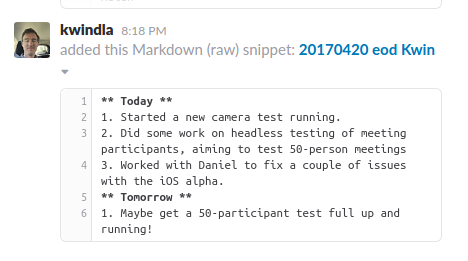
This post is updated and published here, as part of our new blog launch. It originally was published Jun 13, 2017, on Medium and Hacker Noon. Thanks!
If you’re a startup founder, you probably struggle at least a little bit with managing the communications rhythms for your team.
Figuring out good communications heartbeats is one of the important basics of startup management. But, like pretty much everything about startup management, basic isn’t the same thing as easy.
Almost every time I talk to first-time founders, questions about internal communications come up. I have strong opinions about this, as I’ve lived through the early-stage startup growth curve a number of times, and have seen over and over how important good communications rhythms are to the happiness of startup teams.
Small is beautiful
When you’re very small — two or three people — you can usually get away with totally ad-hoc communications. But it’s not too early to start being a little bit organized and proactive. This is especially true if you are a distributed team working in different locations. And once you grow above three people, putting in place even a little bit of structure really helps with productivity.
Here’s an approach that I think works pretty well for most startups, up to about 15 people.
- Very short daily standup meetings. Each person in the company gives a brief (one to two minutes) summary of what she did yesterday, what her priorities are today, and any blockers or major things she needs from other team members.
- Weekly company priorities meetings. These meetings are run by one person, to keep them focused and efficient. That person starts out by summarizing the company’s current goals. Then everyone goes around the circle, briefly going over what they are working on, and how what they are working on aligns with the company goals. The person running the meeting keeps things moving. This meeting shouldn’t take more than an hour.
- Every quarter, the company devotes a half-day to a “how are we doing and what are we doing next” conversation.
- Every week, founders have coffee, or a meal, or a long walk together outside the office.
- Every week, each founder/manager has a 1:1 meeting with each of her direct reports. This is time for the employee to tell the manager what’s on his mind, and to solicit feedback.
You can probably see a pattern here. The first three meetings are focused on keeping everyone mutually informed and aligned around a common set of goals. The weekly meeting is a longer version of the daily meetings, with more emphasis on context. And the quarterly meeting is a longer version of the weekly meeting, with even more emphasis on context.
Maintaining shared context is harder than you might think
It turns out that maintaining a consistent sense of context is non-obviously hard, even for a small team. There are bunch of reasons for this, but the simplest way to think about it is that there’s a big information asymmetry between a company’s founders and everyone else. Founders at a small company see almost everything that’s going on, have the whole history of the company in their heads, and have been thinking all the time about the company for longer than the company has existed. That’s not true for other people on the team.
A friend told me, a long time ago, that you have to say something seven times before everyone in your company has heard and internalized it. That stuck with me, because at the time I was struggling to manage a company that had “only” about 50 or 60 people in it. The simple idea that “you have to say it seven times before it sticks” was like a lens that allowed me to focus on one of the things I was not doing well as a founder. I had not worked hard enough at figuring out how to reliably communicate our company context to everyone. (I hadn’t even figured out that that was something I needed to figure out.)
The other two meetings
Meeting #4, the founder eat-and-walk-and-talk is about carving out time for open-ended conversations. It’s critical that co-founders work to stay in sync. And the founder “brain trust” is one of a startup’s critical resources. The weekly coffee/meal/walk is a way to pop up a level from the daily tactical grind and think strategically, together.
Item #5 is a kind of meeting, rather than a specific meeting. One-to-one meetings are about making sure that each employee is as productive and happy at work as possible. This is the employee’s time, not the manager’s time!
If you are a manager and feel like you have a lot to say in the weekly 1:1, that means something’s wrong. Maybe meetings #1 and #2 aren’t doing what they’re supposed to (keeping everyone aligned and mutually informed). Or maybe this employee is struggling and needs more time and mentoring. Or maybe this employee isn’t working out.
So if you are a manager and feel like you come to a 1:1 meeting every week with a lot you want to accomplish, take a step back and try to figure out what’s going on.
The good news is that a little bit of structure goes a long way
Many — perhaps most — people who gravitate to startups are a little bit allergic to structure. That’s a good thing! But it’s not actually very much time or overhead to do all of the above meeting with a small team. And it makes a big difference.
If you are part of a small team and haven’t formalized any communications heartbeats, I recommend giving at least some of this a try.
Keeping the daily standup meetings short takes some practice. So does making the weekly meetings as useful as possible, and organizing good quarterly sessions. But every team I have introduced this structure into gets happier, pretty quickly, even when everybody is busy and nobody does a “great” job running the meetings!
Writing things down
Writing things down is useful, too.
I like for everyone on a small team to write a very short End of Day summary, and a slightly longer End of Week post.
These align with the daily standup and weekly team meetings described above. Again, I want to emphasize that these are short and don’t take much time to write or read. The End of Day summary shouldn’t take more than five minutes to write. The End of Week post usually doesn’t take more than fifteen minutes.
(Sometimes when I’m behind on my thinking and planning, the End of Week post does take longer, but that’s okay. When that happens, the exercise of writing the End of Week post is a forcing function for making sure I’m popping up a level and thinking clearly about what I’m working on.)
At Daily.co, we have an “eod” channel in Slack, and we all post our End of Day snippets to that channel. Here’s one of mine from a few weeks ago.

We maintain our End of Week posts as pages on an internal wiki. Most of us top-post to the same page each week, and we all have a slightly different format we like. Each week I update my first couple of paragraphs to describe our top-level company priorities and current progress. Then I list my individual priorities for the week.
I have to admit that I’ve had mixed success over the years with End of Day and End of Week summaries. Some teams see the value right away and everyone does the EOD and EOW posts all the time. For other teams, that’s not true. But as a manager, I personally find the written elements almost as useful as the meetings.
Growing pains
As companies grow in size, communications structures have to evolve and change. (As companies grow, everything has to evolve and change. Things that work great with 8 people fail miserably for 30 people.)
Also, as companies grow, all of the management stuff gets harder and the details vary more from company to company. So, with the caveat that it’s harder to generalize as you grow past 15 people, here’s an outline of an approach that can work well up to about 50 people.
- Each team within the company has a daily standup meeting. (No more company-wide standups.)
- Weekly all-hands meetings. It’s pretty common to do these on Friday afternoons. A typical structure is: someone talks about company context (current priorities, progress milestones, “wins” that it’s nice to celebrate together); someone from each team gives a short update from that team; Q&A time with company founders/executives; and a demo or more in-depth presentation from one team.
- Weekly executive-team meetings. These are important, and they are a big enough topic that they deserve a post of their own!
- Every week, founders have coffee, or a meal, or a long walk together outside the office. This only becomes more important over time.
- Direct report 1:1 meetings for everyone in the company. If you’re a manager, and you’re not doing 1:1 meetings, you are not doing your job. (This is where I look around guiltily and hope people who have worked for me in the past — and even people working for me now — are forgiving souls.)
A (self-interested) note about video calls
If your team is distributed, you can do all of the meetings I’ve described above as video calls.
Here’s where I plug my own startup …. Please feel free to stop reading.
At Daily.co, we’re a distributed team, and we make 1-click video calling that's unlimited – so we use our own tools every day for all our meetings.
In fact, we started Daily.co because we wanted to build great communications tools for the kinds of small, flexible, creative teams that we like being part of ourselves.
We’d love for you to try out Daily.co. Just click on your personalized meeting link in Chrome (and, soon, Edge/Safari.) It's free on your computer, with no time limits, free dial-in, and recording. You can customize your URL, like you.daily.co, at our site here. And if you need a conference room system, we make a hardware upgrade, for wireless presentations, always-on and 1-click on your TV. Thanks for reading, and let me know any feedback!

